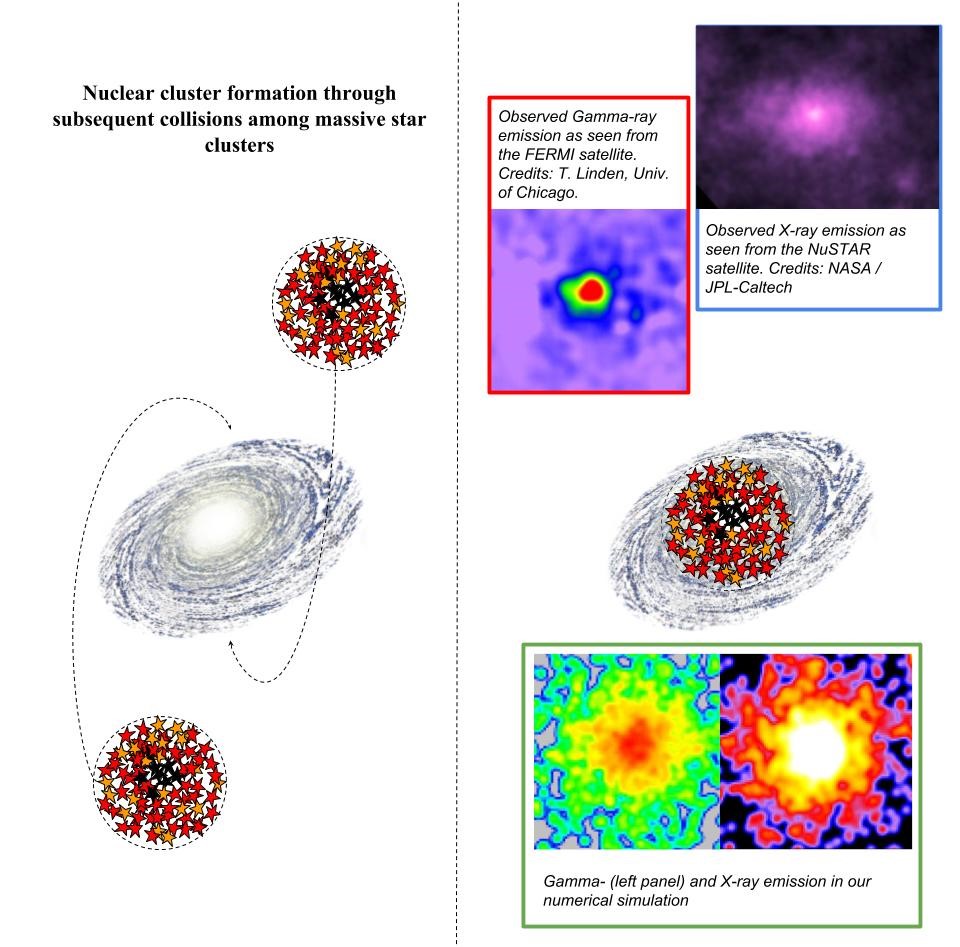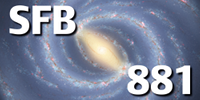A bright spot in the dark: Gamma and X-rays tell us the story of the Galactic Center
Aug 26, 2018
A bright spot in the dark: Gamma and X-rays tell us the story of the Galactic Center
June 26th, 2018

Our sun, like all other stars in our home Galaxy, orbits around the centre of the Milky Way. This region some 27000 light years away from us is one of the most fascinating astronomical neighborhoods within our Galaxy and still poses many questions for astronomers. In its centre it hosts a supermassive black hole called Sagittarius A* (SgrA*), having a mass 4.5 million times the mass of our Sun, surrounded by a dense conglomerate of stars called a nuclear cluster. Nuclear clusters are the densest known star clusters in the universe and can be found near the centre of most galaxies. How they are formed is still under much debate among astronomers.
Mysterious Emission from the inner parts of our Galaxy
In the past few years, detailed observations of the Galactic Centre obtained with the FERMI satellite revealed an intense flux of gamma-rays coming from this region. Scientists have been puzzled by the origin of this emission. One possible source of these radiation is thought to be emissions of a class of neutron stars, called millisecond pulsars (MSPs), that lives in binary system and rotate extremely fast, several hundred times per second. The faint emission from thousands of these unresolved pulsars could produce the blurry image of Gamma rays.
Shortly after FERMI, NuSTAR and the Chandra satellites observed a large number of sources emitting X-ray radiation. In this case, the most likely candidates are called magnetic cataclysmic variables (CVs), which are stellar binary systems containing a white dwarf that feeds gas from its companion star. Very recently Chandra observations also revealed the presence of several neutron stars and black holes (BHs) in binaries, also feeding from their respective Sun-like companions, all inhabiting the SgrA* neighbourhoods. But why is this region so densely packed with so many of these compact objects? By looking at this question astronomers can infer important information on galaxy formation and evolution processes.
Our current understanding of MSP formation suggests that the number of MSPs that could form in the centre of a galaxy should be much smaller than the amount of detected Gamma-ray radiation suggests. However, this discrepancy between observations and theory can be alleviated if the MSPs origin is connected to the evolution and growth of the inner galactic regions.
Massive, high-energetic binary systems as sources of these emissions
A team of astronomers led by Manuel Arca Sedda, researcher at the Heidelberg University, together with Bence Kocsis (Eotvos Lorand University) and Tim Brandt (University of California Santa Barbara), in a recently published study have shown that there is a connection between the observed Gamma and X-ray fluxes and the origin of the Galactic nuclear cluster, making use of state-of-art computer modelling of the Milky Way inner regions.
These simulations in fact support the idea that the nuclear clusters form through a series of repeated collisions between massive star clusters that slowly spiralled toward the Galactic Centre due to a phenomenon called dynamical friction. This formation mechanism, known as ‘dry-merger’ scenario, proves well at explaining the observed relation between nuclear clusters and their hosting galaxies.
During the cataclysmic phases that drive the nuclear cluster formation, the disrupting star clusters deposit their population of dense high-energy objects into the growing nucleus. Indeed, star clusters are perfect factories of MSPs, CVs and BHs, making the ‘dry-merger’ scenario an appealing mechanism to accumulate these sources into the Galactic Centre.
"Our results reproduce very well the observed Gamma- and X-ray fluxes", explains Dr. Arca Sedda illustrating their work (Figure 1), "The simulations suggest that disrupting clusters can pack into the galactic centre as much as thousands of MSPs and CVs, thus providing an excellent explanation for the large number of sources that are expected to orbit those regions. Moreover, our results also allowed us to infer a number of BHs inhabiting the galactic centre perfectly within the observational limits, another indicator for the dry-merger scenario of the formation of the nuclear star cluster." These results may be another step on the way to solving the evolutionary history of our galactic centre.
The scientists also produced a movie showing their simulations on the formation of the nuclear star cluster, that can be found here.
Additional Information:
The results described here were published in: Manuel Arca-Sedda, Bence Kocsis und Timothy D. Brandt, Gamma-ray and X-ray emission from the Galactic centre: hints on the nuclear star cluster formation history in the journal Monthly Notices of the Royal Astronomical Society.
This work was supported by the subproject Z2 of the Collaborative Research Center (Sonderforschungsbereich) SFB 881 "The Milky Way System" at Heidelberg University. Collaborative Research Centers are long-term research projects funded by the Deutsche Forschungsgemeinschaft (DFG) for up to 12 years.
The research work of SFB 881 revolves around our own galaxy, the Milky Way, a typical spiral galaxy and hence a member of the most common class of massive galaxies in the universe. The scientists involved in the SFB investigate the origins and evolution of the Milky Way and its surroundings in order to clarify fundamental principles of galaxy formation.
The SFB 881 is located at the Zentrum für Astronomie der Universität Heidelberg (ZAH) and includes scientists from the Astronomisches Rechen-Institut (ARI), the Institute of Theoretical Astrophysics (ITA) and the Landessternwarte Königstuhl (LSW). The participating non-university research institutions are the Max Planck Institute for Astronomy (MPIA) and the Heidelberg Institute for Theoretical Studies (HITS). In addition, the Haus der Astronomie (HdA) helps to make research on the Milky Way accessible to the general public.
Contact Information:
Public Outreach:
Dr. Renate HubeleSonderforschungsbereich 881 „Das Milchstraßensystem“
Public Outreach
Tel. +49 6221 528-291
Email: hubele(at)hda-hd.de
Scientific Contact:
Dr. Manuel Arca-SeddaZentrum für Astronomie der Universität Heidelberg
Astronomisches Rechen-Institut
Email: m.arcasedda(at)ari.uni-heidelberg.de)


